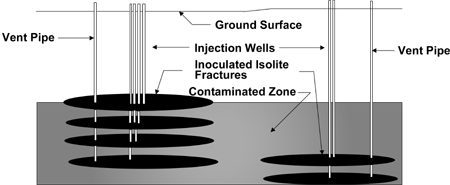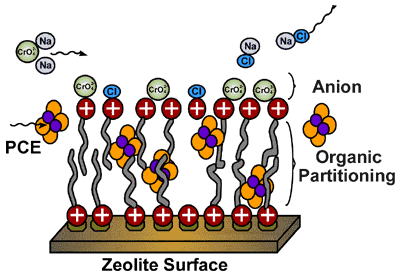Ground Water Currents, March 1999, Issue No. 31ContentsCoal-Derived Humic Acid for Removal of Metals and Organic Contaminants Bioremediation Barrier Emplaced through Hydraulic Fracturing Pilot-Scale Testing of a Surfactant-Modified Zeolite PRB New Information Network Formed in Europe Coal-Derived Humic Acid for Removal of Metals and Organic Contaminantsby David L. Schwartz, U.S. Department of Energy The use of coal-derived humic acid material to remediate ground water contaminated with mining wastes was demonstrated recently by the U.S. Department of Energy (DOE) using waters from the Berkeley Pit in Butte, MT. This demonstration was conducted under DOE’s Resource Recovery Project, which focuses on the evaluation of technology systems for reclaiming usable water and the identification of marketable resources from surface and ground water contaminated with heavy metals. Pilot-scale demonstration results indicate that, in addition to removing heavy metals, application of this ion exchange/adsorbent polymer (HUMASORB-CSTM) can produce a chelated micronutrient-enriched fertilizer product suitable for agricultural application. The Berkeley Pit, which is an open-pit mine that was designated a Superfund site in 1987, has been filling with acidic, heavy-metal laden water since pumping operations ceased in 1982. Water enters the Berkeley Pit at a rate of five million gallons per day (MGPD) from both ground water and surface water flows. Ground water contributes about 70 percent of inflow into the Berkeley Pit (3.5 MGPD) and surface water about 30 percent (1.5 MGPD). The surface water flow has been diverted to minimize the flow of surface water and reduce the overall flow of water into the Berkeley Pit. In the two-stage process used on Berkeley Pit waters, the water first was treated with a liquid HUMASORB product to remove iron and other agricultural micronutrients by formation of humates that are precipitated as flocs. The precipitated complex was separated in a solid/liquid separation unit and remaining metals then were reduced using a cross-linked and immobilized solid humic acid product (HUMASORB-CS). Analysis of metals in the Berkeley Pit water before and after treatment indicated that concentrations fell to near or below detection limits, as shown in Figure 1.
Figure 1. Metal Concentrations in Berekely Pit Water Product characterization tests conducted by Montana State University indicated that the micronutrients derived from the Berkeley Pit waters are utilized by plants, with no difference between the uptake of nutrients from the Berkeley Pit water versus that obtained from a commercial source. In addition, increased yields of 35 percent for alfalfa and 20 percent for wheat were identified following application of the micronutrients. Full-scale application of this technology for the Berkeley Pit is estimated to cost $51 million with an internal rate of return of 33% and a pay-back period of less than three years. For this application, the Berkeley Pit water will be pumped from the pit and treated with HUMASORB to recover the precipitated micronutrient complex. Additional studies have been conducted to evaluate the effectiveness of HUMASORB at treating chlorinated organics and for in situ permeable reactive barrier applications. Early batch tests with HUMASORB-CS for treatment of simulated groundwater contaminated with chlorinated organics showed that the half-life was less than two hours for trichloroethene and tetrachloroethene, in contrast to 15.3 and 6.3 hours using zero-valent iron technology. Additional tests conducted by Temple University researchers confirmed that the humic acid material not only effectively adsorbs chlorinated organic contaminants, but also degrades the contaminants through the process of reductive dehalogenation. In addition, HUMASORB-CS is being evaluated for effectiveness in a simulated barrier system comprising barriers at depths of 10 feet and 100 feet. A simulated waste stream containing a mixture of metals, organics, and radionuclides was passed through the barriers at pressures of 10 pounds per square inch gauge (psig) and 100 psig for more than eight months, with no observed breakthrough. DOE is considering implementation of a full-scale, in situ demonstration of a HUMASORB-CS barrier for an extensive chlorinated organic ground water plume at DOE’s Paducah Plant near Paducah, KY, during 1999. For additional information, contact David Schwartz (DOE) at 412-892-6298 or E-mail schwartz@fetc.doe.gov, or Dr. H.G. Sanjay (ARCTECH, Inc.) at 703-222-0280 or E-mail envrtech@arctech.com.
Bioremediation Barrier Emplaced through Hydraulic Fracturingby Sandra Stavnes, U.S. Environmental Protection Agency, Region 8 The U.S. EPA, General Services Administration, and the State of Colorado jointly sponsored a demonstration of an innovative bioremediation barrier to remediate both ground water and soil containing total petroleum hydrocarbons (TPH) at the Denver Federal Center in Denver, CO. This approach was selected as an alternative to expensive excavation and disposal processes that otherwise would have been required in the tightly-packed clay and shale existing at the site. At the end of the 9-month demonstration, TPH concentrations had fallen by an average of 91.5 percent. Installation of a bioremediation barrier through hydraulic fracturing provides an excellent in situ environment for microbes to metabolize contaminants in ground water and soil. Hydraulic fractures are constructed and kept propped open by the simultaneous injection of small ceramic pellets made from diatomaceous earth (isolite). The pellets, which are 74 percent porous, are saturated with a liquid inoculum of selected indigenous microbes and nutrients that degrade the contaminants. The isolite pore spaces are small enough to protect the selected degrading microbes, but large enough to hold the nutrients, water, and oxygen required for bioremediation. Using this technology, isolite serves to transport microbes into soil and groundwater, maintain the opening and permeability of fractures, and create a permeable reactive treatment system that increases contact time with contaminants. Diverse government operations have been conducted at the Denver Federal Center over the years. Contaminants targeted during the demonstration were derived from cutting oil that had been released during the 1940s when the Center served as a munitions plant. The average TPH concentration prior to the demonstration was 5,700 mg/kg. The Denver Federal Center test area extended approximately 80 by 40 feet on the surface, and 22 feet deep. Fractures were created at the base of pre-drilled cased wells of varying depths. Using high pressure water jets, niches were cut at the bottom of each well to initiate horizontal fracturing. An aqueous guar gum slurry carrying the isolite was introduced into the boreholes and pumped under pressure to extend and fill the fractures. Over a period of two days, a total of six one-inch thick, pancake-shaped, horizontal fractures were created, each extending over 40 feet in diameter and stacked 8-22 feet below ground surface (Figure 2). The cased wells were vented passively through the top of the casing and recessed slightly below the surface in concrete well covers to allow easy access for future recharging, if necessary, and to allow unrestricted traffic flow.
The fractures were installed in the upper layers of the tightly-packed clay. However, perched ground water was present in the clay, resulting in treatment of both soil and ground water at the site. Data suggest that the fractures had increased the soil permeability significantly, thus causing trapped water in the clay to flow through the fractures. As the water passed through the inoculated isolite, the cutting oil was degraded biologically and the “biofractures” served as a permeable reactive treatment system for the ground water. The success of the Denver Federal Center biofracturing demonstration proved to EPA Region 8 and the State of Colorado Oil Inspection Section that this is a promising technology for remediating tightly packed soils and ground water contaminated with TPH. Based on the demonstration results, which were released in 1996, emplacement of bioremediation barriers through the use of hydraulic fracturing has been undertaken recently at two commercial underground storage tank sites in Colorado. Preliminary data for one of these sites show an average reduction in benzene concentration in ground water of 80 percent and a total BTEX (benzene, toluene, ethylbenzene, and xylene) reduction of greater than 85 percent. Final analytical results of the demonstration are available from Sandra Stavnes (EPA, Region 8) at 303-312-6117 or E-mail stavnes.sandra@epa.gov, or Seth Hunt (FOREMOST Solutions, Inc.) at 303-271-9114 or E-mail foremost@earthlink.net. Pilot-Scale Testing of a Surfactant-Modified Zeolite PRBby Robert Bowman, Ph.D., New Mexico Tech Pilot-scale demonstration of the use of a surfactant-modified zeolite permeable reactive barrier (PRB) to remediate contaminated ground water was conducted from July through October 1998 in a contained, simulated aquifer at the Oregon Graduate Institute of Science Technology (OGIST) near Portland, OR. Testing in the aquifer, which was constructed at the OGIST’s Large Experimental Aquifer Program (LEAP) site, is designed to quantify the ability of a surfactant-modified zeolite PRB to intercept and retard the migration of a mixed plume containing 22 mg/L of chromate and 2 mg/L of perchloroethylene (PCE). Zeolites are naturally occurring aluminosilicates with open, cage-like structures and high internal and external cation exchange capacities. Surfactant modification of zeolite constitutes replacing base cations on the external exchange sites of unaltered zeolite with a cationic surfactant. The surfactant forms a bilayer on the surface, resulting in a net positive charge on the zeolite, and increases the organic carbon content to about 5 percent by weight. Sorption of oxyanions occurs via ion exchange to this new surface; sorption of cations occurs via ion exchange and surface complexation to remaining zeolite surface sites; and sorption of organic compounds occurs via partitioning into the new organic stationary phase (Figure 3). The modified zeolite has the ability to sorb these three major classes of contaminants simultaneously.
The simulated aquifer at the LEAP site is filled with sand, with a hydraulic conductivity of 56.7 feet/day. In order to simulate emplacement in front of an advancing plume in a shallow, unconfined aquifer, the surfactant-modified zeolite barrier hangs in the center of the aquifer approximately three feet above its base. The barrier system is constructed of 12 tons of reactive medium, and comprises three 6.5-foot modules totaling approximately 20 feet in length, 3 feet in thickness, and 6.5 feet in depth. Injection and extraction wells controlling the flow system penetrate the entire saturated thickness of the aquifer. Each injection/extraction location consists of paired wells, one screened at the 0.0- to 4.9-foot depth and the other screened at the 4.9- to 9.8-foot depth. Contaminants are introduced only into the upper injection wells, simulating a shallow plume in the upper half of the aquifer. This design provides a full three-dimensional test of plume captured by the PRB. Performance of the barrier system was monitored during a two-month period in which the contaminant plume was injected into the aquifer. Weekly sampling from a network of 63 sample nests with 315 sample points in the aquifer and 18 sample nests with 90 sample points within the barrier was conducted. Test results indicate that the barrier is performing according to design specifications, with retardation factors for chromate and PCE both on the order of 50. The entire plume was captured by the PRB. Based on these experiments, researchers recommend a minimum 100-fold permeability contrast between the PRB and the aquifer material. Costs for construction of the barrier system, which was funded by the U.S. Department of Energy Morgantown Energy Technology Center, were approximately $100,000, including $75,000 for design and $25,000 for installation. Full-scale implementation of the surfactant- modified zeolite PRB is anticipated, pending final analytical results of the pilot-scale tests. Contact Dr. Robert Bowman (New Mexico Tech) at 505-835-5992 or E-mail bowman@nmt.edu for additional information. New Information Network Formed in EuropeA new partnership among European nations, including Belgium, Denmark, France, Germany, the Netherlands, and the United Kingdom, was formed during 1998 to provide an information network for addressing treatment technologies and demonstrations. This partnership, the European Treatment Zones Team (ETZT), aims to foster research needed for areas such as developing reactive materials, designing and modeling hydraulic systems, evaluating technical solutions for depths greater than 10 meters, developing cost-effective and accurate monitoring, and integrating treatment systems. In an effort to establish collaborative projects, the ETZT will hold a joint meeting during May 1999 in France with the Remediation Technologies Development Forum, a multi-agency and private industry organization with similar goals in the U.S. For more information on the ETZT, contact Liyuan Liang (University of Wales) at 441-222-874-579 or E-mail liyuan@cs.cf.ac.uk.
|









